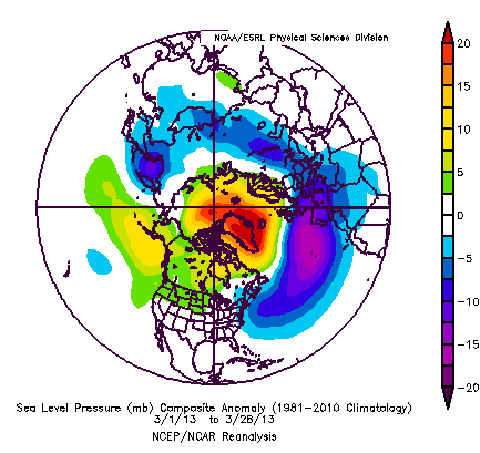 It’s been a cold and snowy end to winter in Britain and much of Europe. The worst March snowfall for 30 years (according to The Telegraph) caused significant disruption to much of the UK, and lead to heavy loss of sheep and lambs in Wales. The UK Met Office reports that March is likely to have been the coldest since 1962, with temperatures running 3ºC below average. The weather pattern that brought the cold outbreak from the east looks set to continue, with only a hint of a return to more normal westerlies and temperatures by the middle of April.
It’s been a cold and snowy end to winter in Britain and much of Europe. The worst March snowfall for 30 years (according to The Telegraph) caused significant disruption to much of the UK, and lead to heavy loss of sheep and lambs in Wales. The UK Met Office reports that March is likely to have been the coldest since 1962, with temperatures running 3ºC below average. The weather pattern that brought the cold outbreak from the east looks set to continue, with only a hint of a return to more normal westerlies and temperatures by the middle of April.
Over the last few years I’ve made more than a few references to the emerging relationship between warming in the Arctic and the loss of sea ice to changes in the patterns of Northern Hemisphere weather. Take a look at this map, plotted at NOAA’s ESRL site using NCEP/NCAR reanalysis data (click on the image to see the original plot):
The chart shows sea level pressure anomalies (departures from average) for March ((Up to March 28th – the latest data available at the time of writing.)). The big red blob shows high pressures anchored over Greenland and Iceland. The big band of purple and blue to the south shows low pressure. Around high pressure systems (anticyclones) in the northern hemisphere the wind blows clockwise, and so the the white band between the high and low pressure zones shows the predominant wind flow. For Britain and most of Europe, that’s been bringing cold Siberian air out of the east, and delaying the end of winter. In more “normal” years, westerlies would dominate the weather, delivering the sunshine and showers so typical of a British spring. On the western edge of that high pressure, the wind from the south has been bringing significant warmth to western Greenland and the Labrador Sea.
How does this relate to Arctic warming? Last week, German climate scientist Stefan Rahmstorf, head of the Potsdam climate research institute, took the opportunity to look at recent research into the relationship between Arctic sea ice loss and the cold outbreaks that have been a feature of recent winters in western Europe. In a blog post, translated into English by the multilingual lagomorph Mr Eli Rabett ((Give the lad a carrot.)), Rahmstorf arrives at a straightforward conclusion:
…the above studies provide strong evidence for a link between Arctic ice loss due to global warming, more frequent winter high pressure, especially over the Atlantic-European part of the Arctic, and an associated influx of cold air to Europe.
It’s worth reading Rahmstorf’s post carefully ((Either at Eli’s or at Neven’s sea ice blog where there’s and interesting discussion of what might be going on – and the impacts of “sudden stratospheric warming” events [Weather Underground, BBC].)) to see how researchers are beginning to piece together the impact that the changing Arctic is having on atmospheric dynamics in the northern hemisphere.
This is science struggling to keep up with the pace of climate change as it happens — fascinating to watch, and frightening at the same time. As the Arctic continues to warm, and the ice continues to disappear, the impacts are in danger of running ahead of our understanding. One thing we can be sure of — the Arctic is not about to stop melting. We’re in for a wild ride, if this winter is anything to go by…


Good post, Gareth; which sums up how I’ve also read the changing weather patterns in the UK and Western Europe. The jet stream is currently really low (around the Straights of Gibraltar) and the forecast is saying this weather will continue until mid April. It’s killing the farmers, coming on top of last summers flooding.
There have been quite a few articles in the last week talking about what’s happening in Greenland—which has been sitting between +5 and +10C for most of the week, while here in the SW of the UK we’ve been hovering around 2-3C. Here’s one I tweeted.]
Note the comment at the end of that article, which sums up many people’s misguided/self-centred attitude: “The hotter, the better,” Pedersen said. “For me”. I’ll give him the benefit of the doubt and read the last two words as irony.
I have a question. How do these pressure systems relate to temperature? Are we to assume that the high pressure areas on the map are hotter? And if so, and the hot air rises, why isn’t cold air rushing in to fill it? I think the difficulty for the non-scientist here is how temperature and air pressure relate. From a common sense point of view, it’s obvious that the melting ice is going to bring colder weather south, but there seem to be some devils in the detail.
Anyway, thanks Gareth. I saw a much longer and more complex presentation of this over at Climate Progress which had me going cross-eyed, at the limit of my poor poet-brain. Clarification welcome!
High pressure systems consist of clear, dry, cool air descending from high altitude. As the clockwise rotating systems approach Europe from the West they drag cold air from the Polar regions.
They are related to warm weather because the sky is clear and we get sunny weather but the air is actually cooler than a low pressure system.
I have a question. How do these pressure systems relate to temperature? Are we to assume that the high pressure areas on the map are hotter? And if so, and the hot air rises, why isn’t cold air rushing in to fill it? I think the difficulty for the non-scientist here is how temperature and air pressure relate. From a common sense point of view, it’s obvious that the melting ice is going to bring colder weather south, but there seem to be some devils in the detail.
Anyway, thanks Gareth. I saw a much longer and more complex presentation of this over at Joe Romm’s excellent Climate Progress which had me going cross-eyed, at the limit of my poor poet-brain. Clarification welcome!
It is still colder in the arctic, where the cold air is originally coming from. Actic amplification does not mean the arctic is hotter than further south.
I rather like the way NIWA has been maintaining its plots where the anomoly is displayed between a plot of the average and a plot of currently observed values while other values are plotted similarly – rainfall, temperature, sunshine etc. on the page. Anomally plots are very useful but I experience people reading them quite inappropriately. I was able to explain this at a meeting recently making use of NIWA’s plots to visually show that the large reduction in rainfall on the West coast of the South Island did not mean it was no longer the wettest place in the country.
Your question illustrates the need for more comprehensive representation where anomalys are a visual part of a public explanation.
thanks noefuller,
Your comment is helpful. Reading standard deviation and anomaly graphs is a kind of basic mathematical literacy, but not all of us have even that level of background. It’s silly, course, but red areas on a map will look hotter than blue areas! After reading your comment, and Thomas’ below, I went back and looked at the map carefully and figured it out.
It’s one of those things that’s clear once you see it!
It is interesting, though, that the map is not the instant visual argument the graphics people might have hoped it was.
Kiwipoet: Its the other way around: High pressure systems represent sinking air masses while low pressure systems have rising air masses. Perhaps this will assist: http://www.atmosphere.mpg.de/enid/3sf.html
Thanks Thomas,
See note above. It makes sense that a sinking airmass will push air outwards, in this case southwards into Europe.
I’ll be interested in the effect on the synchronisation or lack thereof of light cues and thermal cues of the delayed spring on flora and fauna. Spring has been steadily advancing puting migratory birds for example out of phase with their food supply so does this weather pattern reset the clocks momentarily?
With the bad weather in the North caused by the Arctic loss of sea ice and the jet steams I had a quick look to see if our drought had any similar cause. Not the loss of ice,but the stationary jet streams. The answer was, not very likely. http://www.climateoutcome.kiwi.nz/drought.html
Thanks for this link Bob. I’ve been trying to relate expansion of the tropics and sub-tropics with increase in thermal gradient in the south versus decrease in the north & what’s happening to the jet streams in our part of this world?
Some recent studies do suggest that the southern hemisphere circulation could become more prone to increasingly “sticky” weather patterns. One suggestion is that Indian Ocean warming can act as a “pin” for Rossby waves, setting up a static wavetrain that could lead to exactly the sort of weather we’ve had in NZ this summer. But that’s speculative stuff at the moment…
Kiwi post, do you really believe that record cold weather is caused by global warming?
Read the original post (and the comments policy). Contribute to the discussion, or you will be put on moderation. Last warning.
I’m going to predict no change in behaviour. I suspect I won’t be alone.